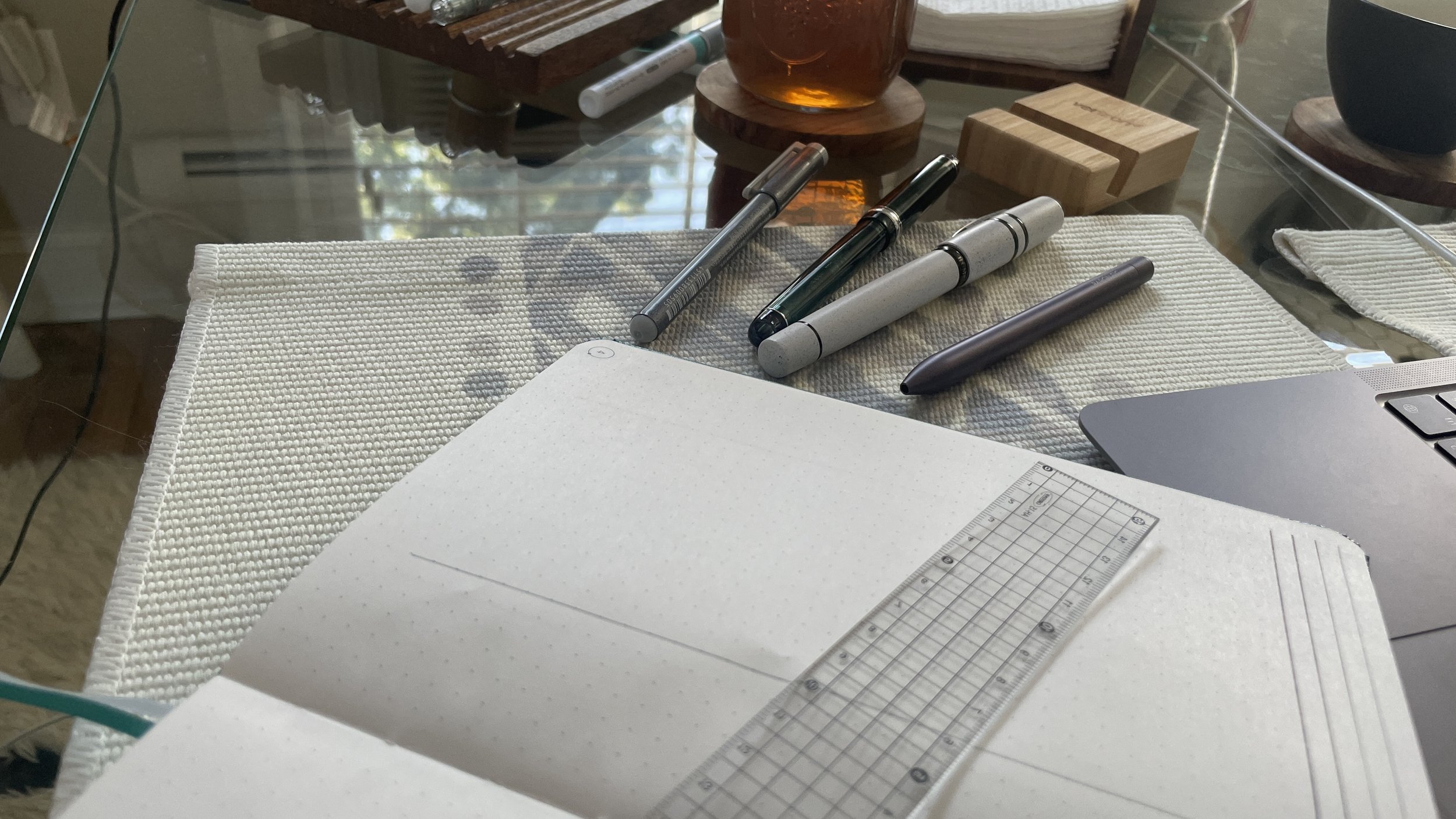My bullet journals are as useful as my last index update
Bullet journals the internet-over are beautiful repositories of lists, reference information, and daily obligations. Artwork, lovely lettering, smudge-free spreads abound. Amid the intricacies and beauty, many guides on creating your own bullet journal suggest beginning with an index — a markedly less exciting task. This is even true for the official Bullet Journal’s guide.
I built out my own index this week. And I revisited past indexes to revise according to what worked and what hasn’t in prior years. This week I share my current approach to making an index that works for me. A “what I’m doing” tour, not a “what you should do.”
The index calls up the pages I most-often return to in the course of a school year. I frequently thumb to index pages before digging into old meeting notes or reference pages.
The index is where the proverbial money lives when it comes to my teaching bujo. And it’s the part of a bullet journal that I see shared online but rarely.
Pre-plan for how you will search your entries. There are two tried-and-true methods for keeping a notebook index. One is chronological. A list of pages from the beginning of the notebook to the end. A table of contents.
Second is topical. Organized into sections by the kinds of entries. All meetings listed together on one page. And reading notes listed together on another. Like a glossary.
I take bits of both approaches, sorting chronologically with threaded topics. Entries are in monthly groups. And each row is a threaded account of related pages throughout the notebook. What a twist.
So I can search all of my meetings related to a specific student easily, off of the same row in my index
A bonus: threading similar entries cuts down on the amount of “index making time” needed to keep my index updated. It’s quicker to write “95” for a new meeting entry on page 95 than an entire new row about a follow-up meeting I already have a row dedicated to.
So many pages of curriculum review on the same class …
Use a color code. Firstly, I opt for ballpoints and gel pens when maintaining the indexes in my bullet journals. Not fountain pens.
Gasp.
I find large categories — all in the exact same color — easily searchable. My ballpoint refills stay the same over long stretches of time. But I change fountain pen inks frequently and often. A lot.
So, tapping one ballpoint for the entire month ensures that all of August’s entries are the exact same red. And then the same for all of September’s entries.
Neat and tidy. And grey and burgundy.
Follow the same formula for every entry. My perfect bullet journal index is quickly searchable. Searchablity is built on knowing exactly where I can find different kinds of information on the page.
Every index entry begins with a one-word genre: meeting, or lesson, or reading.
Then I record a dash, followed by a few short words describing the specific topic(s) included on the page. “Plagiarism investigation” or “paper revision” or “Yilek reading notes.”
And, finally, the number of the notebook pages that information is scribbled on.
Have I over-thought my index? Without a doubt. Have I overdesigned my index pages? Possibly. Do I feel relief when I’m able to quickly call up notes on a random meeting from two months ago when it arises during a meeting with a parent this month? Heck yes.
And I get to play with pens to do so. Wins all around.
This week’s Inked Tines update includes last week’s currently inked writing tools.
Toolset
Pens. I kept returning to my Pilot Custom 74 throughout the week. I know I have a standout combo in my hands when I can’t help but smile as I write. Reliable, consistent, narrow lines. With fun shading. Detailed notes, bullet journal headings and guest lecturer scheduling pages. A firm hand brings out slightly wider lines when emphasis is needed. A tailor-made note-taking combo. For example: D&D notes. 1/3 left.
Monteverde Giant Sequoia (F CI) — Empty. The combination of true-to-size F lines and sharp italic grind demand careful attention to your writing angle — and a stable, flat writing surface. Slow, methodical writing tasks suit this combo best: journaling, reading notes, and analytical lesson plan prep.
Nakaya Neostandard (Mini Naginata) — Feed. The forgiving nature of this grind suits a wide variety of writing tasks. EF detailed accent notes. F scratch notes and D&D notes. M reflections during long writing sessions. A combo well-worth repeating.
Franklin-Christoph 03 (F SIG) — 1/3. True-to-size F writing with noticeable line variation. Wet enough to bring out infrequent sheen. Suited to detailed notes and short reflections. Reading notes, some journaling, and commonplace notes.
Sailor Pro Gear (Z) — 1/3. This pen and ink combination has me seeking out excuses to write. The relative small size of this Pro Gear also led to this pairing making regular outings as my pocket carry. The Z nib was great at odd angles common to writing in pocket notebooks perched in one’s hand. And the reverse EF lines made signing receipts positively fun. And journaling.
TWSBI 580-AL (B) — 2/5. I grew to enjoy this combo more as Fukagawa-nezu darkened in the TWSBI’s feed. Broad silver-grey lines produced halos around the edges of letters. Headings that are simple — and have personality. Fukagawa’s lack of shading kept headings clear and undistracting. Some journaling, too.
Carolina Charlotte (B) — 1/2. Wet, generous B lines. Shading and sheen aplenty. And a comfortable, wide pen section that keeps hands from cramping over long writing sessions. My go-to journaling combo. Occasional notetaking where whimsy was called for.
Visconti Homo Sapiens (EF) — ?? Murky near-black lines. Robbed of any noticeable undertones. However, writes beautifully. I keep reaching for this pair when building out work bujo pages.
Notebooks. Work bujo. Odyssey Neptune (A5). The teaching bullet journal begins life this coming week with 22 pages of prepared indexes and reference pages.
Every single page was sketched out with my three grey-inked pairings. The Pilot’s hairline EF for detailed information. The Visconti’s wider and much darker EF lines for dividers and layouts’ structures. And the TWSBI’s B lines for headings.
Non-murderous Greyjoys
I feel quite ready for my first week of pre-school year meetings.
Journal. LIFE Kleid Noble Note (B6). Twelve new pages entered into my journal over the course of the week. Five entries of widely varying lengths and kinds. Fresh.
I leaned on my three widest nibs for the week’s three longform journal entries. The Sailor’s Z nib for a two-page reflection on one of Stanley’s ideas. The Carolina B for a reflection on changes I wanted made in my teaching bullet journal. And the TWSBI’s B nib for the final paragraph of a loose reflection on my day.
The remaining pages are a compilation of lists and scratch notes made with the Sequoia and Pilot and Visconti.
Written dry. I fully expected the Monteverde Giant Sequoia to run dry this week. It began the week with just enough ink to be viewable over the metal banding at the bottom of the crew-in Monteverde converter.
The Sequoia made good on Thursday while I vetted research for my school’s first DEI session of the year. Scratch notes on what I thought will be useful to discuss within a handful of recent real-world school ethics cases.
Sleep soundly, sweet sequoia
Newly inked. Crickets. Glorious, bored crickets.
I was spoiled for choice with eight inked pairings to work with. The result of a well-chosen currently inked.
The collection
Incoming / new orders. No new purchases this week.
Outgoing / trades or sales. My energies have been focused on setting aside pens to remove from my collection. Earlier reflections on two of my four trays highlighted nine contenders.
So far, I imagine letting go of two Lamy Safaris, my TWSBI Eco-T, the Franklin-Christoph 03 and the Franklin-Christoph 46.
I also continue to contemplate swapping my Franklin-Christoph 31 for a different colorway of the same model.
And removing all three vintage Esterbrook J pen bodies. I enjoy the vintage nibs but would like to foray into Esterbrook’s larger modern pens which use converters instead of sacs.
Currently reading and listening
Fiction. I continued sailing through Anthony Ryan’s The Martyr this week. Primarily in the dimly-lit hours of early mornings. I currently stand at 82% complete — 32% further than at this point last week.
The storytelling remains dark with excellent pacing. I do have hangups about which characters are given agency. However, I’m having fun reading through the ways a scribe impacts broader events in Alwyn Scribe’s world.
Unplugging has been worth it.
Nonfiction. I feel accomplished when I finish a new book. I knocked out my first read through of Jason Stanley’s How Propaganda Works — finishing at last on Saturday morning. 230 pages of preliminary reading. Sweet.
A first read-through, for me, is about identifying the major arguments an author makes. And where, in the text, the author makes those arguments.
A pencil is my best friend during first read throughs. Quick scrawlings in the margins summarize points and connect points to one another.
Quickly-scratched vertical lines tie related lines of text together
All to produce rough, big picture, outlines of the arguments made in key chapters. Sentence fragments and page numbers dominate my notes at this stage of reading.
Inedible graphite breadcrumbs to follow Stanley’s argument
Music. One of my favorite “in the background” while reading or writing musicians is Sleepy Fish. Office and classroom and study friendly.
Clever, subtle orchestration. Guitar plays a prominent role in Fish’s melodies. And it’s just present enough to keep me focused on my work. This is the way.
Lo and behold: Sleepy Fish dropped a new album, A Note from my Book, on August 25. A superb — and sleepy — way to enter the school year.










